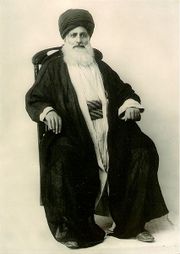Allamah Sayyed Muḥsin b. ʿAbd al-Karīm al-Amīn al-ʿĀmilī was born to a well-known family in Jabal Amel, Lebanon on 1867.
He is son of ‘Abd al-Karim al-‘Amili and he was born in 1284/1867 to a well-known Sayyed family (the Prophet’s (s) descendants) in Chaqra, a village in Jabal Amel, Lebanon. His Mother was a daughter of al-Shaykh Muhammad Hasan Falhat al—Maysi, a righteous scholar of his time. His lineage goes back to al-Husayn Dhi al-Dam’a son of Zayd al-Shahid.
Education and Teachers
After elementary education in his hometown, he learned logic, Arabic syntax, and rhetoric in one of the villages of Jabal Amel. Then, he took part in classes of Musa Shararah.
In 1308/1890-1, he immigrated to Najaf and stayed there until 1319/1901-2. He was a student of great Shi’a scholars such as, Muhammad Taha Najaf, Aqa Rida Hamadani, and Akhund Khurasani. He studied fiqh and usul al-fiqh in the classes of Muhammad Baqir Najmabadi and Sayyed Ahmad Karbala’i and then attained the level of ijtihad.
In addition to fiqh, he also was a good poet, a literary critic, and was knowledgeable in Arabic literature as well.
Students
- Al-Sayyed Hasan, his cousin
- Al-Sayyed Mahdi b. Hasan Al Ibrahim
- Munir ‘Asiran
- Al-Sayyed Amin b. ‘Ali Ahmad
- ‘Ali b. Muhammad al-Marwa al-‘Amili
- ‘Abd al-Latif al-Shibli
- Adib Taqi al-Dimashqi
- ‘Ali Suri
- Mustafa Khalil Suri
- ‘Ali Jamal al-Dimashqi
Cultural Activities and Trips
As he stated in his book al-Rahiq al-makhtum, he immigrated to Damascus for revitalizing and spreading religious teachings and correcting what he considered opposite to both reason and religion. There, he engaged in scholarly and cultural activities for more than half a century.
Al-Sayyed Amin became a member of Damascus’s Arabic Scientific Assembly in 1361/1942 and remained an active member until the end of his life. He established several schools to promote cultural educations of Shi’a youth and wrote some textbooks.
To acquire certain scholarly sources, he traveled to different regions like Syria, Jordan, Palestine, Egypt, Iraq, and Iran.
Personal and Scholarly Merits
He is known as a brave scholar in expressing his ideas, like his objection to some rituals in the mourning for Imam al-Husayn (a) which put him in a very difficult fighting situation. He had the two qualities of criticizing some sects and attitudes and endeavoring for building Islamic Unity together in his scholarly character. Although he refuted beliefs of Wahhabism in his works Kashf al-irtiyab]] and al-‘Uqud al-durriyya. He emphasizes the necessity of unity in Islamic Ummah in his work Haqq al-yaqin fi luzum al-ta’lif bayn al-muslimin.
Works
A’yan al-Shi’a
Main article: A’yan al-Shi’a (book)
A’yan al-Shi’a is his most important work, which is a comprehensive reference containing biographies of Shi’a noble figures. A remarkable portion of the book is dedicated to biographies of Shi’a Imams (a); however regarding the expansion of the notion of Twelver Shi’a, the book has included biography and the works of 11,733 individuals to present Shi’a cultural identity and show the role of Twelver Shi’as in the progress of Islamic civilization. The book is a great biographical reference of important Shi’a figures, from early years of Islam to scholars contemporary to the compiler, including Sahaba (companions of the Prophet Muhammad (s)) Tabi’un and experts of different fields including narrators, experts of hadith, reciters and exegetes of the Qur’an, jurists, Islamic philosophers, theologians, preachers, poets, experts in Arabic syntax, lexicography, morphology and rhetoric, logicians, mathematicians, astronomers, and even political figures like kings and ministers.
A’yan al-Shi’a consists of ten large volumes, of which the first one and half volumes are the introduction and the biographies of the Prophet (s), Lady Fatimah al-Zahra (s) and Shi’a Imams (a). The rest are biographies of other Shi’a figures.
Other works
Another work of Sayyed Amin is Haqq al-yaqin fi luzum al-ta’lif bayn al-muslimin (True certainty in necessity of unity amongst Muslims) in which he emphasizes the necessity of unity in Islamic Ummah.
His other work is Kashf al-irtiyab fi ‘itba’ Muhammad b. ‘Abd al-Wahhab, in which he refutes the beliefs of Wahhabbism.
His other famous work is Lawa’ij al-‘ashjan fi maqtal al-Husayn (a), in which he discusses the event of ‘Ashura.
Among his noticeable works is al-Tanzih li-a’mal al-shabih which has been written in objection to some of common ways of mourning among Shi’a and considers acts like tatbir against the Islamic Law.
Some of his works are:
- Naqd al-washi’a
- Tarikh Jabal ‘Amil
- al-Bahr al-zakhkhar fi sharh ahadith a’immat al-athar (a)
- Irshad al-juhhal
- Al-Durr al-munazzam fi mas’alat al-taqlid al-a’lam
- Asas al-shari’a
and more than 70 other titles.
Demise
Al-Sayyed Muhsin al-Amin passed away in the midnight of Rajab 24, 1371/April 19, 1952 in Damascus and was buried in front of the main entrance of the Shrine of Sayyeda Zaynab (a).
 Ijtihad Network Being Wise and Faithful Muslim in the Contemporary World
Ijtihad Network Being Wise and Faithful Muslim in the Contemporary World

